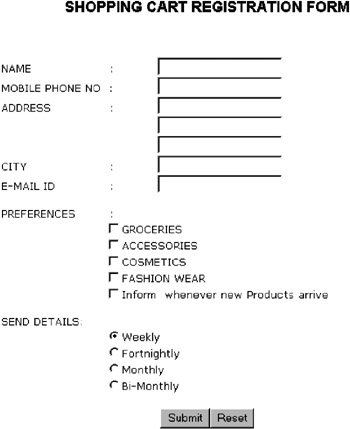CHAPTER 33
|
| < Day Day Up > |
|
-
You can download WAP toolkits from the Web sites of Nokia, Ericsson, Motorola, and others. These tookkits can be used to develop and test mobile applications in the lab before deploying the applications in the actual mobile network environment. Using WML and WML Script, you can create good applications and test them. The framework for developing a mobile commerce application using the push model is given in the following.
Assume that there is a Web site that provides the facility to buy various items through your mobile phone. The Web site also sends the latest information about new arrivals in the items of your choice. To start with, you need to register yourself with the Web site and give details such as your mobile phone number, your preferences, and the frequency with which you would like to receive the advertisement information. A sample registration form is shown in Figure C.13.

Figure C.13: Registration form for mobile push application.Once you are a registered user of the Web site, you keep getting information from the Web site using the push model. You can also use the mobile cart to place an order for different items.
To achieve this functionality, you need to create the necessary HTML files, a database that stores the complete information about all the registered users, and Java programs that run on the server and send the information to the users. You also need to create the WML file that provides the interface to the user on the mobile device.
The screenshot with the first screen of the mobile commerce application is shown in Figure C.14.

Figure C.14: M-commerce application on a mobile phone. -
J2ME facilitates the development of mobile applications using the Java programming language. Keeping in mind the limitations of the mobile devices such as small display, limited functionality keypad, and so on. The J2ME provides limited GUI capabilities and is optimized to work on devices with less memory. You can download the J2ME kit from Sun Microsystems Web site.
-
Binary runtime environment for wireless (BREW), developed by Qualcomm, facilitates development of mobile applications for CDMA-based wireless networks. You can download the kit from Qualcomm's Web site http://www.qualcomm.com.
-
Mobile phones do not have an operating system. However, devices such as personal digital assistants and palmtops have an operating system. The operating systems that are ported on the mobile devices are known as mobile operating systems. Palm OS, developed by Palm Computing Inc., is the most famous mobile OS. Other operating systems that now have a large installation base are Symbian OS, Windows CE and Windows XP. Embedded Linux has also gained importance in recent years.
-
When a mobile device moves from one service area to another service area, to ensure that there is no disruption in the service, mobile IP is required. In mobile IP, the mobile device is given two addresses, called home address and care-of address. The home address is a permanent address, and the care-of address is a temporary address that is given when the mobile device is in a foreign area. The packets addressed to the mobile device will be received by the home network and forwarded to the care-of address.
-
You can obtain information from the following sites: http://www.nokia.com, http://www.ericsson.com, http://www.microsoft.com.
|
| < Day Day Up > |
|
EAN: 2147483647
Pages: 313